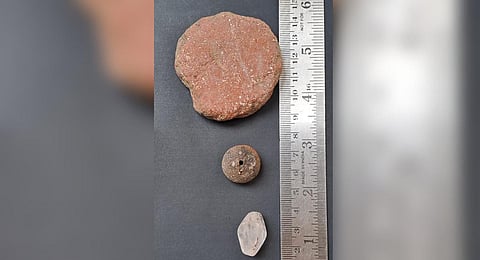

TIRUPATTUR: In a preliminary surface survey conducted at Gundureddiyur village beside Yelagiri Hills in Tirupattur on Tuesday, experts unearthed several archaeological remains that date back to the Sangam period.
State archaeological officer Ranjith and his team conducted the survey following multiple requests from A Prabhu, assistant professor in the department of Tamil of Sacred Heart College, Tirupattur.
Subsequent to the preliminary survey, it has been informed that there is a possibility of designating the place as an archaeological site, and excavations may be conducted at this location in the future.
The findings include black and red wares, biconical beads, iron ores, and spindle whorls used by ancient people for weaving. In 2016, Prabhu stumbled upon archaeological evidence, including fragments of black wares, red wares, and iron ores, during a surface field survey conducted on a 80-acres private farm in Gundureddiyur village. Subsequent phases of research at the site led to the discovery and documentation of various archaeological remains.
Following this, Prabhu approached the Department of Archaeology for an investigation and excavation, unveiling the life history of the ancient people who resided in the location. In 2017, a formal request was submitted to the then archaeology minister Ma Foi K Pandiarajan and the Department of Archaeology, urging them to conduct a field survey by submitting his findings. With the change in the government, another appeal was made to the current Minister of Archaeology Thangam Thennarasu and the secretary of the archaeology department.
Following this, Ranjith conducted a preliminary surface field survey. He told TNIE, “In response to Prabhu’s petition, I initiated a surface field survey, revealing numerous archaeological findings. These include black and red wares commonly used in the early historical period, evidence of iron ore indicative of iron smelting activities at the site, suggesting the presence of a living cum industrialised habitation. Additionally, we discovered biconical beads from the early age and spindle whorls, ancient tools used in weaving.” He also mentioned that during his survey he explored archaeological evidence that was documented by Prabhu at his college.
During the survey, Ranjith found an inscription and hero stones near the hillock. While searching for a riverbed, a crucial aspect as early settlements are typically located near water sources, he identified the Kattaaru, which existed in the past.
He added, “To designate the location as an archaeological site, literary evidence, in conjunction with other archaeological findings, is essential. In Tamil Nadu, there are nearly 2,000 such sites exhibiting archaeological remnants. However, excavation procedures will be carried out based on priority. I have proposed this location and submitted a report to the department.”
Prabhu said, “The preliminary field survey has sparked hope, and the archaeology department should acknowledge that northern districts also have such archaeological sites and officially designate the area as one.”